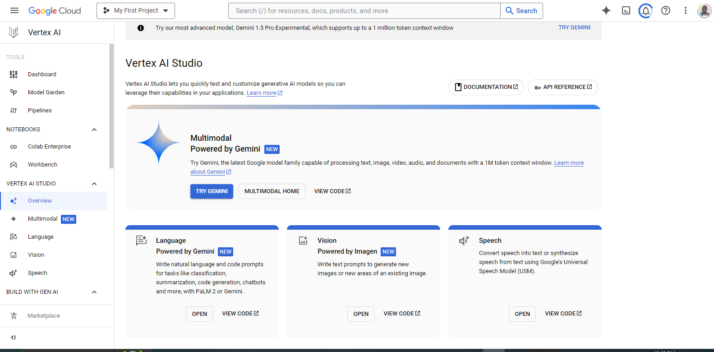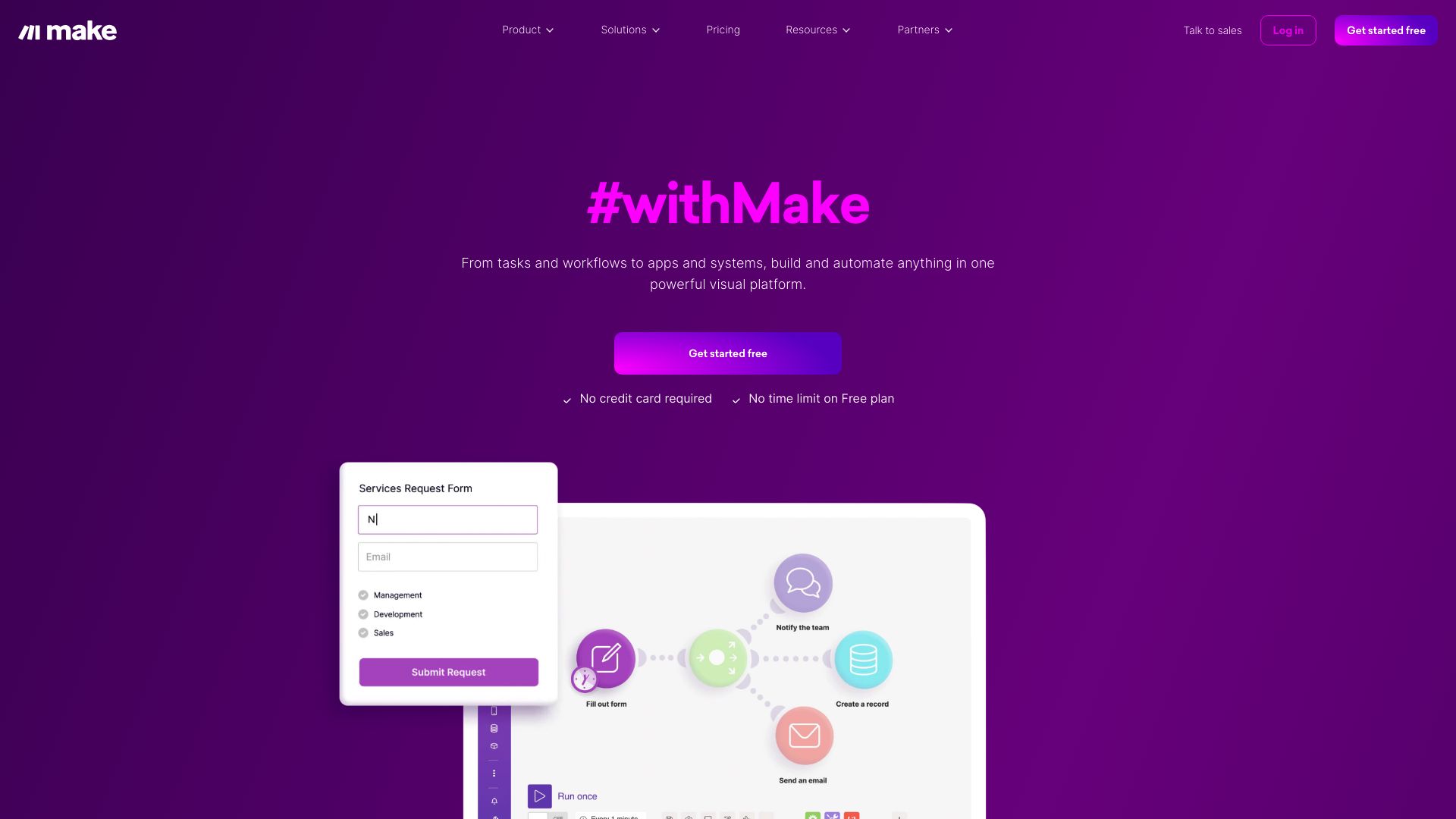Vertex AI vs. Make.com: A Comprehensive Feature Comparison
As AI technology continues to reshape industries and redefine possibilities, businesses seek powerful yet accessible solutions to harness its potential. This comparison explores Vertex AI vs. Make.com, and SmythOS, three platforms that approach AI and automation from different angles. Vertex AI offers robust machine learning capabilities and enterprise-grade features, while Make.com excels in no-code workflow automation.
SmythOS emerges as a compelling alternative, combining advanced AI capabilities with user-friendly interfaces. This review delves into each platform’s strengths, limitations, and ideal use cases, providing valuable insights for developers, business leaders, and AI enthusiasts alike. Whether you’re looking to deploy sophisticated AI models, streamline workflows, or find a versatile solution that bridges both worlds, this comparison will guide you through the key features and considerations of these innovative platforms.
Vertex AI Overview
Vertex AI empowers developers to build, deploy, and scale machine learning models and AI applications. This comprehensive platform integrates data engineering, data science, and ML engineering workflows, streamlining the entire AI development lifecycle.
Vertex AI’s standout feature is its Gemini model, a multimodal powerhouse capable of processing text, images, audio, and video inputs. Gemini excels in advanced reasoning, multiturn chat, and code generation, making it a versatile tool for diverse AI applications. The platform’s Model Garden offers a curated selection of pre-trained models, including Google’s proprietary offerings and select open-source options, enabling rapid prototyping and deployment.


Screenshot from Vertex AI studio.
Vertex AI’s standout feature is its Gemini model, a multimodal powerhouse capable of processing text, images, audio, and video inputs.
For enterprises and AI professionals, Vertex AI provides robust MLOps capabilities. The Model Registry centralizes version control, while the Feature Store efficiently serves ML features. These tools, combined with performance monitoring and workflow orchestration, ensure smooth operation of AI systems at scale. Specialized models like Imagen for text-to-image generation and MedLM for healthcare applications further expand Vertex AI’s utility across industries.
Despite its power, Vertex AI has limitations. The platform requires coding knowledge, lacking a true no-code option for model development. This may present a barrier for non-technical users seeking to leverage AI capabilities. Additionally, while Vertex AI offers extensive API support, it doesn’t mention direct integration with popular automation tools like Zapier, potentially limiting some workflow automation options.
Vertex AI positions itself as a robust, scalable solution for organizations serious about implementing AI. Its strengths in model customization, multimodal capabilities, and enterprise-grade features make it a formidable player in the AI platform space. However, its learning curve and focus on technical users may not suit all organizations, particularly those seeking simpler, code-free AI solutions.
Make.com Overview
Make.com offers a visual no-code platform for workflow automation and integration between apps and services. The platform’s drag-and-drop interface enables users to build complex workflows, called scenarios, connecting data between over 1000 pre-built app integrations.
Make.com offers a visual no-code platform for workflow automation and integration between apps and services.


Make.com’s strength lies in its ability to automate tasks without coding. Users can visually model workflows, test and edit them rapidly, and share them across organizations with granular permissions. The platform offers tools to transform, filter, and manipulate data within workflows, along with detailed execution logs for debugging.
Make.com’s strength lies in its ability to automate tasks without coding. Users can visually model workflows, test and edit them rapidly, and share them across organizations with granular permissions.
While Make.com excels in workflow automation, it lacks some advanced AI capabilities. The platform doesn’t offer a dedicated no-code AI editor or built-in foundation AI models. This limitation may impact users seeking to create sophisticated AI agents or leverage cutting-edge machine learning techniques.
Make.com scales from personal use cases to enterprise-grade solutions, with options ranging from free to enterprise plans. The platform’s cloud-based hosting and robust scheduling features make it suitable for businesses of various sizes. However, users requiring deep AI integration or extensive customization may find the platform’s capabilities somewhat restrictive.
Integration with external services is a key feature of Make.com. The platform connects to any API, allowing for extensive customization and expansion of its base functionality. This flexibility enables users to incorporate AI services from other providers, partially mitigating the lack of built-in AI tools.
Feature Comparison
Vertex AI and Make.com offer contrasting approaches to AI and automation. Vertex AI provides powerful machine learning capabilities with multimodal AI models like Gemini, extensive MLOps tools, and enterprise-grade features. Make.com focuses on no-code workflow automation and integrations between apps and services.
Core components differ significantly between the platforms. Vertex AI includes advanced AI model development and deployment tools, supporting multimodal inputs and offering specialized models like Imagen for text-to-image generation. Make.com lacks built-in AI modeling capabilities but excels in visual workflow building and app integrations. This gap limits Make.com’s ability to create sophisticated AI agents compared to Vertex AI’s comprehensive AI toolkit.
Security features also diverge between the platforms. Vertex AI provides robust data encryption, OAuth support, and IP control for access management — critical for enterprise AI deployments. Make.com offers basic security features for workflow automation but lacks the depth of AI-specific security measures found in Vertex AI. This difference highlights Vertex AI’s focus on enterprise-grade AI solutions versus Make.com’s emphasis on accessible workflow automation.
Feature Comparison Table
| Vertex AI | Make.com | SmythOS | |
|---|---|---|---|
| CORE FEATURES | |||
| AI Agents | ✅ | ❌ | ✅ |
| Hosted Agents (Dev, Production) | ✅ | ❌ | ✅ |
| Environments (Dev, Production) | ✅ | ❌ | ✅ |
| No-Code Options | ❌ | ✅ | ✅ |
| Memory & Context | ✅ | ❌ | ✅ |
| Autonomous Agents | ✅ | ❌ | ✅ |
| Explainability & Transparency | ✅ | ❌ | ✅ |
| Multimodal | ✅ | ❌ | ✅ |
| Problem-Solving Capabilities | ✅ | ❌ | ✅ |
| Multi-Agent Collaboration | ✅ | ❌ | ✅ |
| Human-AI Interaction | ✅ | ❌ | ✅ |
| Audit Logs for Analytics | ❌ | ✅ | ✅ |
| SECURITY | |||
| Constrained Alignment | ✅ | ❌ | ✅ |
| Data Encryption | ✅ | ❌ | ✅ |
| IP Control | ✅ | ❌ | ✅ |
| COMPONENTS | |||
| Foundation AIs | ✅ | ❌ | ✅ |
| Huggingface AIs | ❌ | ❌ | ✅ |
| Zapier APIs | ❌ | ❌ | ✅ |
| Classifiers | ✅ | ❌ | ✅ |
| Data Lakes | ✅ | ❌ | ✅ |
| DEPLOYMENT OPTIONS (EMBODIMENTS) | |||
| Deploy as API | ✅ | ❌ | ✅ |
| Staging Domains | ✅ | ❌ | ✅ |
| Production Domains | ✅ | ❌ | ✅ |
| Deploy as Site Chat | ✅ | ❌ | ✅ |
| DATA LAKE SUPPORT | |||
| Hosted Vector Database | ✅ | ❌ | ✅ |
| Sitemap Crawler | ❌ | ❌ | ✅ |
| YouTube Transcript Crawler | ❌ | ❌ | ✅ |
| URL Crawler | ✅ | ❌ | ✅ |
| PDF Support | ✅ | ❌ | ✅ |
| Word File Support | ✅ | ❌ | ✅ |
| TXT File Support | ✅ | ❌ | ✅ |
Best Alternative to Vertex AI and Make.com
SmythOS stands out as the superior alternative to Vertex AI and Make.com, offering a comprehensive AI agent development platform that combines powerful capabilities with unparalleled ease of use. Our platform bridges the gap between advanced AI technologies and practical business applications, making it accessible to users of all skill levels.
We designed SmythOS to address the limitations of both Vertex AI and Make.com. While Vertex AI provides robust machine learning tools, it lacks the intuitive interface and no-code options that make AI development truly accessible. Make.com, on the other hand, offers workflow automation but falls short in providing sophisticated AI agent creation capabilities. SmythOS combines the best of both worlds, delivering a platform that is both powerful and user-friendly.
Our drag-and-drop interface allows users to create complex AI workflows without extensive coding knowledge. This visual approach to AI development sets us apart from Vertex AI’s more technical interface, enabling a broader range of users to harness the power of AI. Unlike Make.com, which lacks built-in AI modeling capabilities, SmythOS provides a comprehensive toolkit for creating sophisticated AI agents that can handle a wide array of tasks.
SmythOS combines the best of both worlds, delivering a platform that is both powerful and user-friendly.
Security is a top priority in SmythOS. We offer robust data encryption, OAuth support, and IP control for access management — critical features for enterprise-level AI deployments. These security measures surpass those of Make.com and match the enterprise-grade protections of Vertex AI, ensuring that your AI agents and data remain secure.
SmythOS truly shines in its flexibility and unlimited use cases. Our platform supports integration with various AI models, including those from OpenAI, Anthropic, and Hugging Face, providing a level of versatility that neither Vertex AI nor Make.com can match. This extensive integration ecosystem, combined with our multi-agent orchestration capabilities, allows for the creation of AI solutions that can tackle complex, real-world problems across industries. Whether you’re building a customer service chatbot, automating data analysis, or creating an AI-powered decision support system, SmythOS provides the tools and capabilities to bring your vision to life.
Conclusion
Vertex AI, Make.com, and SmythOS each offer unique approaches to AI and automation, catering to different needs and skill levels. Vertex AI provides powerful machine learning capabilities and enterprise-grade features, ideal for organizations with deep technical expertise. Make.com excels in no-code workflow automation, connecting various apps and services effortlessly.
SmythOS, however, strikes an optimal balance between power and accessibility. Our platform combines the strengths of both Vertex AI and Make.com, offering advanced AI capabilities with a user-friendly interface. SmythOS’s drag-and-drop builder enables rapid development of sophisticated AI agents without requiring extensive coding knowledge. This democratization of AI development sets SmythOS apart, making it suitable for both technical and non-technical users.
While Vertex AI and Make.com have their merits, SmythOS’s comprehensive feature set, including multimodal support, autonomous agents, and extensive integrations, provides a more versatile solution for businesses of all sizes. Our platform’s ability to deploy AI agents across various environments, from APIs to chatbots, offers unparalleled flexibility in implementing AI solutions.
For those looking to harness the full potential of AI without the steep learning curve, SmythOS is the clear choice. We invite you to explore our diverse range of AI-powered agent templates and experience the future of AI development. Create a free SmythOS account today and join the AI revolution, transforming your workflows and driving innovation across your organization.
Last updated:
Disclaimer: The information presented in this article is for general informational purposes only and is provided as is. While we strive to keep the content up-to-date and accurate, we make no representations or warranties of any kind, express or implied, about the completeness, accuracy, reliability, suitability, or availability of the information contained in this article.
Any reliance you place on such information is strictly at your own risk. We reserve the right to make additions, deletions, or modifications to the contents of this article at any time without prior notice.
In no event will we be liable for any loss or damage including without limitation, indirect or consequential loss or damage, or any loss or damage whatsoever arising from loss of data, profits, or any other loss not specified herein arising out of, or in connection with, the use of this article.
Despite our best efforts, this article may contain oversights, errors, or omissions. If you notice any inaccuracies or have concerns about the content, please report them through our content feedback form. Your input helps us maintain the quality and reliability of our information.
